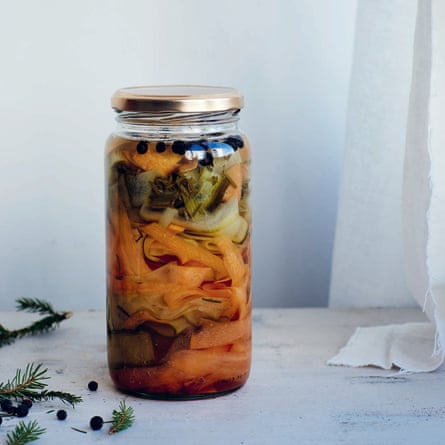
Over the next week, millions of trees will be ejected from homes across the UK as Christmas festivities draw to a close.
But instead of sending their pine, fir and spruce trees for recycling or replanting, growing numbers of eco-conscious households are trying to make the most of them by eating various parts before throwing them out. Fir trees can be used in ice-cream, to pickle vegetables and even to flavour gin.
Food experts say the needles can be used like rosemary or bay leaves in cooking to create a flavour of citrus and pine, and are also a good source of vitamin C. The wood can also be burned to make pine ash, which can be used in gardens and for cleaning as well as in the kitchen.
Michelin-starred chefs are also among fans. John Williams, executive chef of the Ritz restaurant, says “fragrant and spicy” needles can be used to enhance the flavour of celeriac among other ingredients. René Redzepi, of three-Michelin-starred Noma in Copenhagen, told the Observer pine has been a regular fixture at his restaurant for almost 20 years.
“You can pretty much eat the whole thing,” said Julia Georgallis, author of How to Eat Your Christmas Tree. “You can use the needles as you would use rosemary or bay leaves, for flavour.”
She recommends wearing gloves to handle a spruce tree, as they can be quite spiky. For an even more chef-like option, she suggested making pine ash by putting sections of tree in a hot oven until charred before whizzing in a blender to create a black powder to use as flavouring.
Needles can also be used to pickle eggs or vegetables and in drinks and infusions. For those who replant their trees, she recommends eating the new buds in spring.
The London-based baker and food writer has been working with Christmas trees for years. When she first started, few people took any interest, she said. Since then the idea has rapidly gained traction.
Her sellout Christmas tree supper club will run later this week at Host of Leyton in east London. The menu includes stuffed, deep-fried olives, carrot cured with beetroot and fir-lox, spruce ice-cream sundae, and pinenut fudge brownie served with pinenut brittle and white pine tea.
While the popularity of foraging and mixology have played a role, she said, the climate crisis is the main driving force. “It’s made everyone a lot more aware of how they’re eating, what they’re eating, how they buy and grow stuff.”
It would be best for the environment not to have Christmas trees in the home at all, said Georgallis, but, for those who cannot give up the habit, the tree should be used as much as possible.

A five-foot Christmas tree is probably about 12 years old, she said. “I don’t know why in a climate crisis, when trees are our best armoury, we’re cutting down thousands a year to keep hostage in our houses.”
Pine products can also be extracted from living trees. Redzepi said he started cooking with pine nearly 20 years ago, using shoots from the forest after he reading about it in a French book. “We went to the forest and stared picking pine shoots – they were incredible,” he said. “We then discovered that the mature needles could add piney and citrusy notes.”
But, he warned, it is vital to use only organic trees, grown without pesticides. “We only go into the wild forest, as some pine farming can be quite toxic,” he said.
Redzepi likes pine’s versatility: “Think of it as rosemary – you can use it in just about anything.”
Organic pine needles can be crushed to flavour gin or vinegar, he said. “That’s something that I think British people would very much enjoy. You can also just blend them into vinegar, for a pine flavour – that is also great.”



